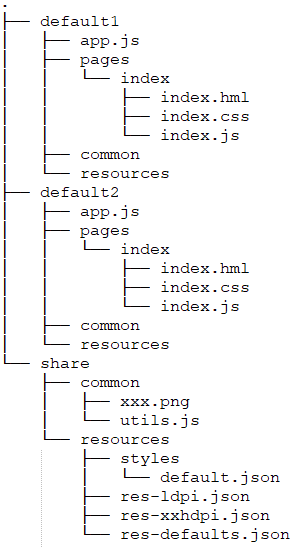# File Organization
## Directory Structure
The following figure shows the typical directory structure of the JavaScript module \(**entry/src/main/js/module**\) for an application with feature abilities \(FA\) using JavaScript APIs.
**Figure 1** Directory structure
.png)
**Figure 2** Directory structure for resource sharing5+

Functions of the files are as follows:
- .hml files describe the page layout.
- .css files describe the page style.
- .js files process the page logic and user interactions .
Functions of the folders are as follows:
- The **app.js** file manages global JavaScript logics and application lifecycle. For details, see [app.js](js-framework-js-file.md).
- The **pages** directory stores all component pages.
- The **common** directory stores public resource files, such as media resources, custom components, and .js files.
- The **resources** directory stores resource configuration files, for example, for multi-resolution loading. For details, see [Resource Limitations and Access](js-framework-resource-restriction.md).
- The **share** directory5+ is used to configure resources shared by multiple instances. For example, images and JSON files in this directory can be shared by **default1** and **default2** instances.
>**NOTE**
>
>- The **i18n** and **resources** folders cannot be renamed.
>- If the same resource name and directory are used under the share directory and the instance \(**default**\) directory, the resource in the instance directory will be used when you reference the directory.
>- The **share** directory does not support **i18n**.
>- You should create the optional folders \(shown in the directory structure\) as needed after you create the project in DevEco Studio.
## File Access Rules
Application resources can be accessed via an absolute or relative path. In the JS UI framework, an absolute path starts with a slash \(/\), and a relative path starts with ./ or ../. The rules are as follows:
- To reference a code file, use a relative path, for example, **../common/utils.js**.
- To reference a resource file, use an absolute path, for example, **/common/xxx.png**.
- Store code files and resource files in the **common** directory and access the files in a required fashion.
- In a .css file, use the url\(\) function to create a URL, for example, **url\(/common/xxx.png\)**.
>**NOTE**
>
>When code file A needs to reference code file B:
>
>- If code files A and B are in the same directory, you can use either a relative or absolute path in code file B to reference resource files.
>- If code files A and B are in different directories, you must use an absolute path in code file B to reference resource files because the directory of code file B changes during Webpack packaging.
>- Use an absolute path if you want to dynamically change the resource file path through data binding in a .js file.
## Media File Formats
**Table 1** Supported image formats
| Image Format | File Format |
| ------------ | ----------- |
| BMP | .bmp |
| GIF | .gif |
| JPEG | .jpg |
| PNG | .png |
| WebP | .webp |
**Table 2** Supported video formats
| Video Format | File Format |
| ------------------------------- | ----------- |
| H.264 AVC Baseline Profile (BP) | .3gp .mp4 |